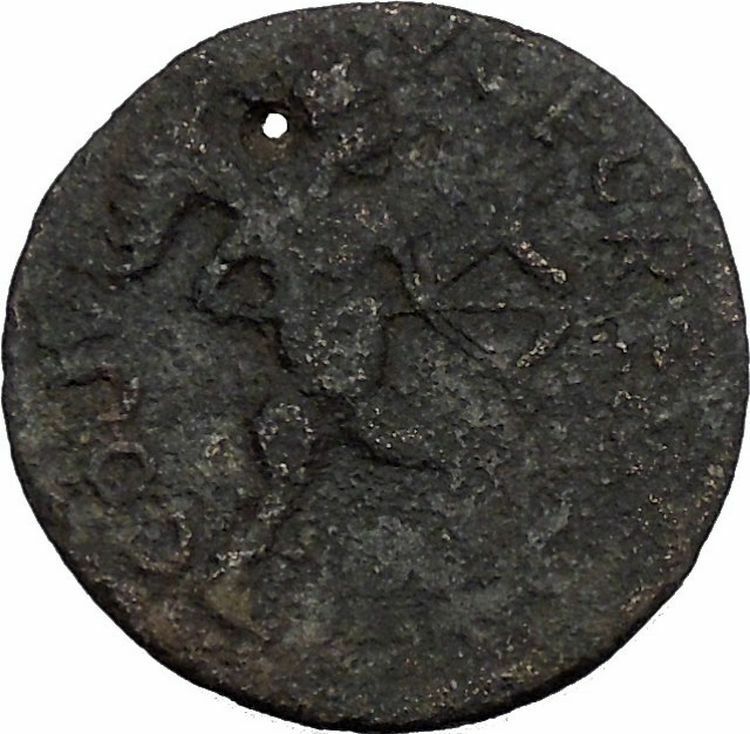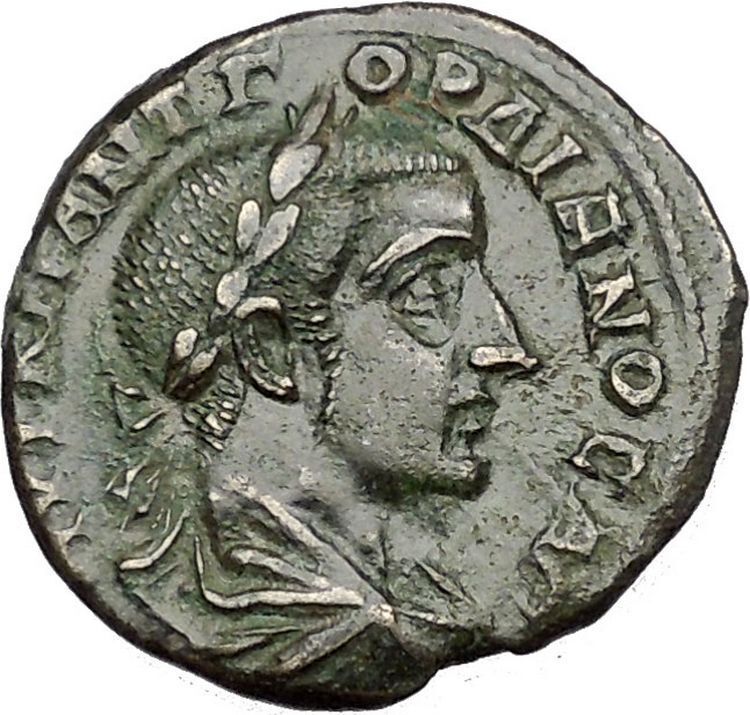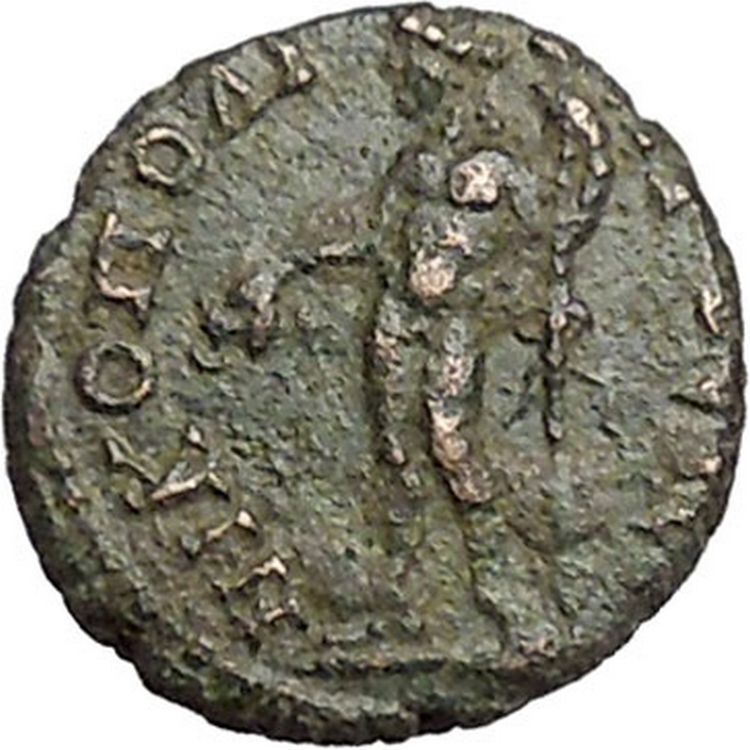|
Julia Domna – Roman Empress Wife of Emperor Septimius Severus 193-211 A.D. –
Bronze 17mm (3.24 grams) of Nicopolis ad Istrum in Moesia Inferior
IOVΛIA ΔOMNA CЄB, draped bust right.
NIKOПOΛITΩN ПPOC ICTP, Nude Apollo standing left, holding patera and branch.
You are bidding on the exact item pictured, provided with a Certificate of Authenticity and Lifetime Guarantee of Authenticity.
 In Greek and Roman mythology, Apollo, is one of the most important and diverse of the Olympian deities. The ideal of the kouros (a beardless youth), Apollo has been variously recognized as a god of light and the sun; truth and prophecy; archery; medicine and healing; music, poetry, and the arts; and more. Apollo is the son of Zeus and Leto, and has a twin sister, the chaste huntress Artemis. Apollo is known in Greek-influenced Etruscan mythology as Apulu. Apollo was worshiped in both ancient Greek and Roman religion, as well as in the modern Greco-Roman Neopaganism. In Greek and Roman mythology, Apollo, is one of the most important and diverse of the Olympian deities. The ideal of the kouros (a beardless youth), Apollo has been variously recognized as a god of light and the sun; truth and prophecy; archery; medicine and healing; music, poetry, and the arts; and more. Apollo is the son of Zeus and Leto, and has a twin sister, the chaste huntress Artemis. Apollo is known in Greek-influenced Etruscan mythology as Apulu. Apollo was worshiped in both ancient Greek and Roman religion, as well as in the modern Greco-Roman Neopaganism.
As the patron of Delphi (Pythian Apollo), Apollo was an oracular god – the prophetic deity of the Delphic Oracle. Medicine and healing were associated with Apollo, whether through the god himself or mediated through his son Asclepius, yet Apollo was also seen as a god who could bring ill-health and deadly plague as well as one who had the ability to cure. Amongst the god’s custodial charges, Apollo became associated with dominion over colonists, and as the patron defender of herds and flocks. As the leader of the Muses (Apollon Musagetes) and director of their choir, Apollo functioned as the patron god of music and poetry. Hermes created the lyre for him, and the instrument became a common attribute of Apollo. Hymns sung to Apollo were called paeans.
In Hellenistic times, especially during the third century BCE, as Apollo Helios he became identified among Greeks with Helios, god of the sun, and his sister Artemis similarly equated with Selene, goddess of the moon. In Latin texts, on the other hand, Joseph Fontenrose declared himself unable to find any conflation of Apollo with Sol among the Augustan poets of the first century, not even in the conjurations of Aeneas and Latinus in Aeneid XII (161-215). Apollo and Helios/Sol remained separate beings in literary and mythological texts until the third century CE.
Nicopolis ad Istrum was a Roman and Early Byzantine town founded by Emperor Trajan around 101-106, at the junction of the Iatrus (Yantra) and the Rositsa rivers, in memory of his victory over the Dacians. Its ruins are located at the village of Nikyup, 20 km north of Veliko Tarnovo in northern Bulgaria. The town reached its apogee during the reigns of Trajan, Hadrian, the Antonines and the Severan dynasty.
The classical town was planned according to the orthogonal system. The network of streets, the forum surrounded by an Ionic colonnade and many buildings, a two-nave room later turned into a basilica and other public buildings have been uncovered. The rich architectures and sculptures show a similarity with those of the ancient towns in Asia Minor. Nicopolis ad Istrum had issued coins, bearing images of its own public buildings.
In 447 AD, the town was destroyed by Attila’s Huns. Perhaps it was already abandoned before the early 400s. In the 6th century, it was rebuilt as a powerful fortress enclosing little more than military buildings and churches, following a very common trend for the cities of that century in the Danube area.The largest area of the extensive ruins (21.55 hectares) of the classical Nicopolis was not reoccupied since the fort covered only one fourth of it (5.75 hectares), in the southeastern corner. The town became an episcopal centre during the early Byzantine period. It was finally destroyed by the Avar invasions at the end of the 6th century. A Bulgarian medieval settlement arose upon its ruins later (10th-14th century).
Nicopolis ad Istrum can be said to have been the birthplace of Germanic literary tradition. In the 4th century, the Gothic bishop, missionary and translator Ulfilas (Wulfila) obtained permission from Emperor Constantius II to immigrate with his flock of converts to Moesia and settle near Nicopolis ad Istrum in 347-8. There, he invented the Gothic alphabet and translated the Bible from Greek to Gothic.
 Julia Domna – Augusta 193-217 A.D. Julia Domna – Augusta 193-217 A.D.
| Wife of Septimius Severus | Mother of Caracalla and Geta | Sister of Julia Maesa | Aunt of Julia Soaemias and Julia Mamaea | Great-aunt of Elagabalus and Severus Alexander | Mother-in-law of Plautilla |
Julia Domna, (Latin: Iulia Domna; c. 170 AD – 217 AD) was a member of the Severan dynasty of the Roman Empire. Empress and wife of Roman Emperor Lucius Septimius Severus and mother of Emperors Geta and Caracalla, Julia was famous for her prodigious learning as well as her extraordinary political influence.
Family background
Julia Domna was born in Emesa (known today as Homs) in Syria. She was the youngest daughter of the high-priest of Ba’al Gaius Julius Bassianus and sister to Julia Maesa, and she had two nieces: Julia Mamaea, mother of Severus Alexander, and Julia Soaemias, mother of Elagabalus. Her ancestors were Priest Kings of the famous temple of Elagabalus. The family had enormous wealth and was promoted to Roman senatorial aristocracy. Before her marriage, Julia inherited the estate of her paternal great-uncle Julius Agrippa, a former leading Centurion.
Reign
In the late 180s, Julia married future emperor Septimius Severus, usually considered to be of Punic background. They had two sons, Lucius Septimius Bassianus (Caracalla) in 188 and Publius Septimius Geta in 189. Because of her love of philosophy, Julia protected philosophers and helped philosophy to flourish in Rome. She was an imperial woman from 193-217 CE as wife to the emperor Septimius Severus and mother to emperors Geta (murdered by Caracalla in 211 CE) and Caracalla (r. 211-217 CE). Julia Domna died shortly after her son Caracalla was murdered.
Civil War or “Year of the Five Emperors”
After Commodus was murdered without an heir in 192 CE, many contenders rushed for the throne. An elder senator, Pertinax, was appointed by the praetorian guard. When Pertinax would not meet the guard’s demands of payment, his son-in-law Iulianus was called to Rome. After bribing the guard, Iulianus was appointed emperor, and Pertinax was murdered. Septimius Severus, coming from the north into Rome, overthrew Iulianus and had him executed. Septimius claimed the title of emperor in 193, and co-ruled Rome with Clodius Albinus until 195 CE when Septimius declared his sons AVGVSTVS, and defeated Albinus and his British legions. Septimius remained at war with an eastern rival to the throne, Niger, until he defeated Niger’s forces in 201 CE. Julia Domna and her sons accompanied Septimius in his campaigns in the East. During this time, titles were granted to Julia Domna reminiscent of titles given to Faustina the Younger, including MATER CASTORVM, or mother of the camp, MATER AVGVSTVS, mother of Augustus, and MATER PATRIAE, or mother of the fatherland.
Imperial Building Project: The aedes Vestae
The fire of Commodus in 192 CE destroyed areas of the aedes Vestae which includes the Temple of Vesta and the home, or Atrium, of the Vestal Virgins. Based on numismatic evidence, historical authors, and a laconic inscription found in situ, most scholars agree that Julia Domna funded restorations to the site during Septimius Severus’s reign.
Controversy and transition of power
As empress, Julia was often involved in intrigues and had plenty of political enemies, who accused her of treason and adultery. None of these accusations was proven. Severus continued to favour his wife and insisted on her company in the campaign against the Britons that started in 208. When Severus died in 211 in Eboracum (York), Julia became the mediator between their two sons, Caracalla and Geta, who were to rule as joint emperors, according to their father’s wishes expressed in his will. The two young men were never fond of each other and quarrelled frequently. Geta was murdered by Caracalla’s soldiers in the same year.
Caracalla was now sole emperor, but his relations with his mother were difficult, as attested by several sources, probably because of his involvement in Geta’s murder. Nevertheless, Julia accompanied Caracalla in his campaign against the Parthian empire in 217.
During this trip, Caracalla was assassinated and succeeded (briefly) by Macrinus. Julia chose to commit suicide after hearing about the rebellion, perhaps a decision hastened by the fact that she was suffering from breast cancer. Her body was brought to Rome and placed in the Sepulcrum C. et L. Caesaris (perhaps a separate chamber in the Mausoleum of Augustus). Later, however, both her bones and those of Geta were transferred by her sister Julia Maesa to the Mausoleum of Hadrian. She was later deified.
Apollonius
If it were not for Julia, there would have survived little information about the philosopher Apollonius of Tyana. It was at the behest of Julia that Philostratus wrote his now famous Life of Apollonius of Tyana. Julia is thought to have died before Philostratus could finish his work of eight volumes.
|





 In Greek and Roman mythology, Apollo, is one of the most important and diverse of the Olympian deities. The ideal of the kouros (a beardless youth), Apollo has been variously recognized as a god of light and the sun; truth and prophecy; archery; medicine and healing; music, poetry, and the arts; and more. Apollo is the son of Zeus and Leto, and has a twin sister, the chaste huntress Artemis. Apollo is known in Greek-influenced Etruscan mythology as Apulu. Apollo was worshiped in both ancient Greek and Roman religion, as well as in the modern Greco-Roman Neopaganism.
In Greek and Roman mythology, Apollo, is one of the most important and diverse of the Olympian deities. The ideal of the kouros (a beardless youth), Apollo has been variously recognized as a god of light and the sun; truth and prophecy; archery; medicine and healing; music, poetry, and the arts; and more. Apollo is the son of Zeus and Leto, and has a twin sister, the chaste huntress Artemis. Apollo is known in Greek-influenced Etruscan mythology as Apulu. Apollo was worshiped in both ancient Greek and Roman religion, as well as in the modern Greco-Roman Neopaganism. Julia Domna – Augusta 193-217 A.D.
Julia Domna – Augusta 193-217 A.D.




